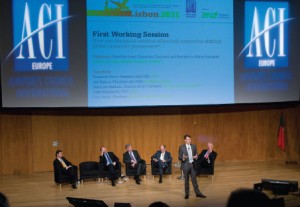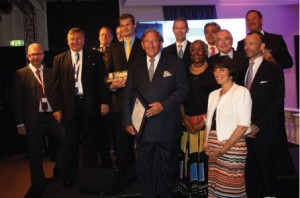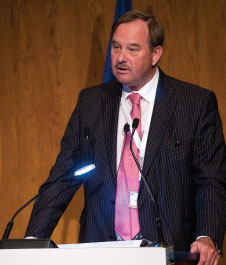
Colin Matthews, CEO, BAA, highlighted the competition that exists between airports such as Heathrow and Amsterdam Schiphol, indicating his belief that regulators do not always understand that competition.
The event attracted more than 400 delegates, including representatives from airports, airlines, aviation service companies and suppliers, air traffic management experts, national governments and the European Commission. It provided a productive forum in which to discuss issues including shifting global economic parameters, adapting to acts of nature on the ground and modernisation in the air, and putting the joy back into the airport experience.
In his ‘State of the Industry’ address, Olivier Jankovec, Director General, ACI EUROPE reported detailed key figures on the European airport industry in 2010 – an uneven 2010, which saw airlines clearly concentrating on yields and 47% of regional airports still losing traffic. With airline capacity remaining unchanged for the year, he particularly underlined the impact of airline volatility on the European airport network. In 2010, airlines opened 4,747 new routes in Europe, but closed 3,330 routes. For 2011, he spoke about a “brighter – yet uncertain – outlook”, with a full-year forecast of +6% passenger growth, but warned that the outlook for freight is less promising. “Changes in the market are tremendous – we’re clearly entering a new era for global aviation,” commented Jankovec, “with massive traffic growth predicted and Asia set to surpass all other aviation markets.”
In his welcome address, Ad Rutten, COO, Schiphol Group and outgoing ACI EUROPE President, said that the past 12 months have provided plenty of evidence that European aviation still faces many challenges. “In my view, they have also revealed the growing importance of getting things right, when it comes to our policy and regulatory frameworks,” he commented.
Rutten shared three key priorities for a strategically oriented policy and regulatory framework supporting European aviation. The first priority is to provide legal certainty. “We used to have that in Europe, and it used to be a competitive advantage over other world regions, where legal uncertainty tended to be widespread. However, in recent years, we have seen worrying examples of European governments abruptly changing the rules for airports, by shifting policy or resorting to unwise regulatory interventions,” said Rutten. “We need a better climate to attract private investors. Our decision makers at national and European level need to get this right – or investors will understandably look elsewhere, or simply be more demanding on returns and guarantees.”
The second priority is to reduce costs and promote both operational and environmental efficiency, while the third priority is to provide new business opportunities. “The maturity of the European market and the boom of aviation in emerging countries mean that our most promising opportunities are now outside Europe. We must be in a condition to attract and develop air traffic flows to and from our external markets. This is essential to protect and reinforce the position of Europe on the global aviation market. And for that, there is only one way: liberalisation!” explained Rutten. “The EU must seriously look at taking a leadership position globally on aviation liberalisation, and make the most of the “first mover” advantage. We need to step up efforts to extend our open aviation market to the East and across the Mediterranean. We also need liberalisation with our trading partners in all emerging markets – the BRICs of course, but also Mexico and the ASEAN countries.”
Keynote addresses were delivered by Luiz Fuchs, President, Embraer Aviation Europe and Carolyn McCall, CEO, easyJet. McCall is the subject of our lead interview (see page 11), but in summary, she described the easyJet vision of ‘Turning Europe Orange’, while maintaining a commitment to increasing efficiency and reducing emissions. McCall, who became easyJet CEO in July 2010, explained that the airline is focused on a network of convenient, primary airports. Referring particularly to airports, she said that they need to reflect changes in the airline market, including “the rise of point-to-point low fares airlines”, “passengers want simple and efficient infrastructure and services” and “investment that passengers value”.
Fuchs offered his perspective on the contribution of emerging economies towards the future of European aviation. “Despite the crisis, non-EU markets have been important contributors for growth,” he said. “The Middle East is partly offsetting the contraction of the market.”
China is expected to become the world’s largest economy by 2029 and, according to Fuchs, “emerging economies will provide strongest support for the growth of the economy and air transport”. “North America and Europe are expected to see a decrease in their market share, but remain strong on aircraft deliveries,” he added. While network carriers are focused on exploring international markets, particularly in Africa, the Middle East and Latin America, the regional carriers are more critical to supporting intra-EU traffic. Around half of deliveries to 2029 are expected to be narrow-body aircraft.
Fernando Pinto, President and CEO, TAP, explained that “the better the networks and hubs operate, the more competitive the airports and airlines are”. “The consolidation movement is reinforcing networks. The problem we’re suffering is lack of investment in infrastructure and new capacity,” he commented.
Jos Nijhuis, President and CEO, Schiphol Group, picked up on the subject of airline consolidation, describing it as “a threat and an opportunity”. “We are blessed at Schiphol that KLM has built a good network in China. Our aim is to be the main European hub for China,” he added.
BAA continues to undertake significant investment at London Heathrow, with a brand new Terminal 2 for the Star Alliance carriers, a refurbished Terminal 4 for SkyTeam and T5C completing the Terminal 5 development for oneworld. Colin Matthews, CEO, BAA, highlighted the competition that exists between airports such as Heathrow and Amsterdam Schiphol, indicating his belief that regulators do not always understand that competition.
Matthew Baldwin, Director of Air Transport, European Commission, spoke about capacity on the ground. “We face up to five million flights not met by 2030. The European Commission is ready to confront this,” he said. “The Single European Sky is grinding into motion. Technology has a role to play in the SES.”
Airport investment
Juan Lema, President, Aena, delivered a special presentation on Spain’s new airport management model. Aena Aeropuertos operates 47 airports and two heliports in Spain and participates, directly or indirectly, in the management of a further 27 airports abroad. “The start of Aena Aeropuertos marks a milestone in the history of airport management in Spain. The new model will allow us to improve competitiveness in an increasingly demanding environment, while implementing an autonomous and flexible business management,” explained Lema.

The ACI EUROPE Best Airport Awards 2011 winners and presenters.
ACI EUROPE Best Airport Award winners 2011
The 7th annual ACI EUROPE Best Airport Awards ceremony took place at the gala dinner during the 21st ACI EUROPE Annual Assembly. This year’s judging panel featured a group of independent experts, including ACI WORLD, EUROCONTROL, ECAC and the Disabled People’s Association (Denmark).
The winners:
![]()
1-5 million passengers category: Bournemouth Airport (owned by Manchester Airports Group)
![]()
5-10 million passengers category: Edinburgh Airport (owned by BAA)
![]()
10-25 million passengers category: ICF Antalya Airport
![]()
Over 25 million passengers category: Amsterdam Airport Schiphol
![]()
Eco-Innovation Award:
*judged by the Advisory Board of Airport Carbon Accreditation
Zürich Airport
Finally, a new award – the WBP Recognition Award – was presented to Harry Diehl, retired top executive of Gebr. Heinemann, in recognition of his leadership in advancing airport retail and developing increased cooperation between airports and their commercial partners through his involvement in ACI’s World Business Partner programme.
Aena Aeropuertos was created in February 2011 and in July the concession companies of Madrid-Barajas and Barcelona-El Prat airports were created. Allocation of the controlling stakes in the Madrid-Barajas and Barcelona-El Prat airport concession companies will take place in December.
“The air traffic increase, the growth of commercial revenue and the cost restraints will allow an improvement of Aena Aeropuertos income statement, which will be profitable in 2012,” commented Lema.
His address was followed by ‘The Airport Investors Forum’, which featured four panellists: David Stanton, Airport Director, MAp; Michael McGhee, Partner, Global Infrastructure Partners; Dr Stefan Schulte, Chairman of the Executive Board, Fraport; and Francois Berisot, Project Director, VINCI Airports.
The aviation industry has demonstrated its resilience in recovering from external shocks. Stanton said that recovery of capacity and passenger traffic is consistent with long-term trends. MAp has a 74% interest in Sydney Airport, a 30.8% interest in Copenhagen Airport and a 39% interest in Brussels Airport. “Current airline capacity increases are being driven by recovery from the global financial crisis and structural changes in the aviation market,” commented Stanton.
He explained that the opening up of bilateral air rights has driven traffic growth at Sydney, particularly in the Chinese and North American markets. Meanwhile, low-cost carrier development has provided significant capacity growth and efficient use of airport infrastructure.
Dr Schulte explained that Fraport’s strategic goals are “value creation, performance and sustainability”. Indeed, profits are increasing across all segments, including aviation, retail and real estate, and ground handling. Schulte outlined some impressive figures, with passenger numbers at FRA to increase by between 4% and 7% in 2011 from the 53 million handled in 2010. 4-7% growth per year is expected to continue until 2015. Meanwhile, revenues of €2.3 billion are expected for 2011.
Acts of nature and ATM modernisation
Adapting to acts of nature on the ground and modernisation in the air was another key theme of the conference. Stewart Wingate, CEO, Gatwick Airport, explained that the unprecedented snowfall of the last winter season presented a stern test of the airport’s crisis management processes. “We learned quickly that the snow equipment we inherited wasn’t up-to-scratch. We have worked with the airlines to devise our snow clearing plans and we visited Scandinavian airports. We created a single ‘Silver Command Centre’ and consistent communication messages,” he said. “Communication was a key focus for us. We embraced social media channels.”
Airport Carbon Accreditation celebrates 2 Years!
The ACI EUROPE Annual Congress in Lisbon saw Airport Carbon Accreditation mark its second birthday after the carbon standard for airports launched by ACI EUROPE at the 2009 event. Following a very promising first year, which saw 18 airports become Airport Carbon Accredited, year 2 saw the programme move up several gears, as 43 airports achieved certification at one of the 4 levels of accreditation. These airports cover the full expanse of Europe from Shannon Airport in Ireland to Antalya Airport in Turkey, from Kristiansand Airport in Norway to Athens International Airport in Greece. Accredited airports also include some of the biggest hubs in Europe including London-Heathrow, Frankfurt Airport, Paris-Charles de Gaulle and Paris-Orly, Amsterdam Airport Schiphol, Munich Airport and Istanbul-Ataturk. In fact, the accredited airports in Year 2 represent over 43% of European passenger traffic. The total CO2 reduction they achieved within Airport Carbon Accreditation is over 720,000 tonnes – equivalent to taking 180,000 cars off the roads.
Airports that are Airport Carbon Accredited to date:
At the ‘Mapping’ level:
ANA, Portugal: Faro, Flores, Horta, Lisbon, Porto, Ponta Delgada and Santa Maria
Bologna, Italy
Budapest, Hungary
Chisinau, Moldova
DAA, Ireland: Cork, Dublin and Shannon
Dubrovnik, Croatia
Eindhoven, The Netherlands
TAV Airports Holding, Turkey: Ankara Esenboga, Istanbul Ataturk and Izmir Adnan Menderes
Prague, Czech Republic
Toulouse Blagnac, France
At the ‘Reduction’ level:
Aéroports de Paris, France: CDG and Orly
Athens, Greece
Kristiansand, Norway
Brussels, Belgium
Frankfurt, Germany
London Gatwick, UK
Hamburg, Germany
ICF Airports, Turkey: Antalya
Farnborough, UK
At the ‘Optimisation’ level:
London Heathrow, UK
Manchester, UK
Munich, Germany
Amsterdam Schiphol, The Netherlands
Zurich, Switzerland
At the ‘Neutrality’ level:
Avinor, Norway: Trondheim and Oslo
SEA Milan Airports, Italy: Milan Linate and Milan Malpensa
Swedavia, Sweden: Göteborg Landvetter, Stockholm Arlanda, Stockholm Bromma and Umea City
To download a copy of the Airport Carbon Accreditation Annual Report for 2010-2011, visit www.airportcarbonaccreditation.org
Gatwick is also midway through implementing Airport Collaborative Decision Making (A-CDM) – in line with the A-CDM action plan of ACI EUROPE, EUROCONTROL and CANSO. This was also picked-up by Philippe Bernand, CEO, Aéroports de Lyon, which launched its own ambitions for A-CDM in May 2011 for implementation by the end of 2012. “Added value in airside operations will come from working together, sharing accurate and timely information, and optimising and anticipating decisions,” said Bernand.
Patrick Ky, Executive Director, SESAR Joint Undertaking, discussed the Single European Sky ATM Research (SESAR) programme. “Today’s air traffic management systems are based on technologies from the 1950s,” he said. “If we want to cope with increased demand for air traffic and increased safety, we can’t do it without new technology.”
ACI EUROPE and the SESAR Joint Undertaking signed a cooperation agreement at the Annual Assembly. “SESAR is an ATM project, but there is substantial benefit in it for airports. We need your engagement and commitment to SESAR,” emphasised Ky.
The event provided an effective forum in which to discuss the key issues currently affecting European aviation. The consensus was that the industry is experiencing a “new reality” both operationally and economically, and that all industry stakeholders must adopt a proactive, collaborative approach in order to evolve their businesses.
The 22nd ACI EUROPE Annual Assembly, Congress and Exhibition, hosted by Aena, will take place in Madrid from 20 to 22 June 2012.
Declan Collier elected ACI EUROPE President
After two terms as President of ACI EUROPE, Ad Rutten, Executive Vice-President and COO, Schiphol Group, has stepped down from the role. At the ACI EUROPE Annual Assembly, Declan Collier, CEO, Dublin Airport Authority, was elected to lead the organisation.
Collier said: “I am honoured to take on this role. Recent years have shown our industry still faces plenty of challenges and that we need a strong representation with policy makers and regulators at European level. More than ever, decisions taken in Brussels affect our business, and that trend is only set to continue. I will work closely with our office and staff in Brussels, and will seek to engage the Board and the membership at large in actively supporting our advocacy efforts. Alongside the strong presence and efficiency of our association, my priority at all times will be on ensuring that we defend the collective interests of all our members – regardless of size, location or business model. This includes members of ACI EUROPE’s World Business Partners programme, as they are an essential component of our association. Beyond our membership, I will strive to reinforce industry cooperation with airlines, ANSPs and other stakeholders – experience has shown that we are far more effective when we work in harmony with other stakeholders in the industry. However, this, to me, has to be compatible with airports being treated and recognised as commercial businesses in their own right.”







